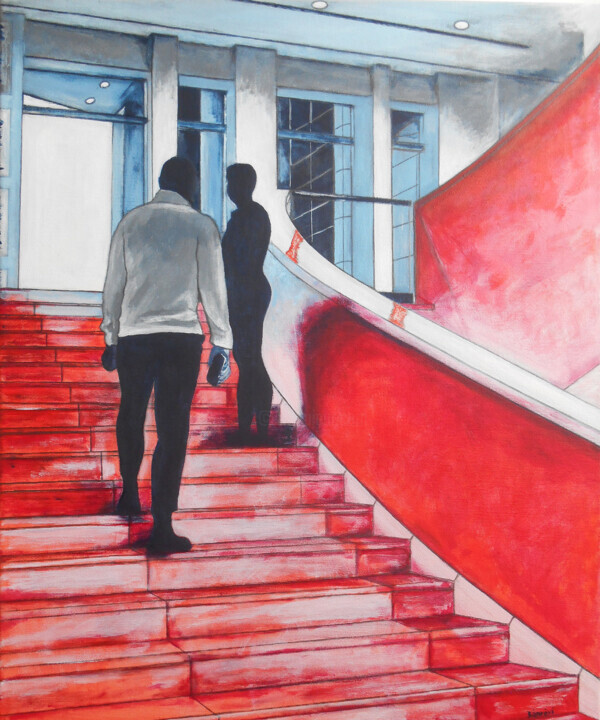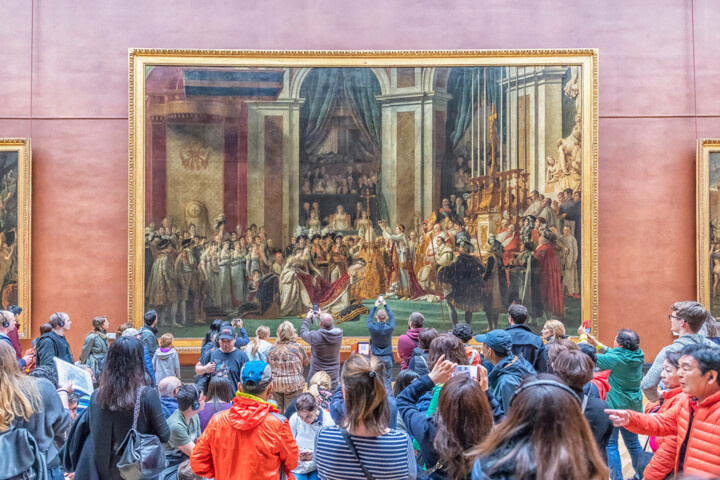Key information
Museums around the world offer real overnight stays, combining art, science and history.
The experience offers a more intimate and sensory relationship with the works.
The phenomenon was born from children's sleepovers, before seducing adults.
These immersive nights are part of the trend of experiential tourism.
A new way of experiencing culture, between contemplation and daydreaming.
 Richard Silver - "Large Painting at the Louvre", 2018. Photograph. 101.6 x 152.4 cm.
Richard Silver - "Large Painting at the Louvre", 2018. Photograph. 101.6 x 152.4 cm.
Sleeping under a blue whale, sharing the night with Egyptian mummies, or waking up in front of an Impressionist work... What was once a dream or a movie script is now a very real experience. Across the world, museums are opening their doors after dark, no longer just for evening visits, but for overnight stays. A concept that borders surrealism, experiential tourism, and artistic passion.
A Night at the Museum, for Real
It all began with sleepovers for children at natural history museums. The concept was simple: offer a fun night surrounded by fossils, stuffed animals, and life-size reconstructions. But what initially emerged as a family-friendly activity has become a true cultural phenomenon, also attracting adults seeking unusual experiences and an intimate connection with art.
Today, the idea is no longer limited to a few hours spent after closing time. Some museums offer real overnight stays, transforming their galleries into temporary rooms. Sleeping in a museum is no longer an exception, but a new mode of artistic exploration.
 Silvia Szlapka - "Exhibition 24", 2024. Oil on canvas. 50 x 50 cm.
Silvia Szlapka - "Exhibition 24", 2024. Oil on canvas. 50 x 50 cm.
A world tour of museums that host you
In New York, between fossils and stars
The American Museum of Natural History offers its famous "Nights at the Museum," during which visitors explore the exhibits by flashlight before unfolding their sleeping bags beneath the imposing suspended blue whale. Nearby, the Intrepid Sea, Air & Space Museum , located on an aircraft carrier, offers another unique experience: stargazing on the flight deck and sleeping next to a space shuttle.
Science and dinosaurs at night in London
The British capital is multiplying its nighttime experiences. The Natural History Museum is hosting "Dino Snores," a night in the heart of the galleries where prehistoric skeletons watch over your sleep. The Science Museum , meanwhile, is offering "Astronights," combining interactive workshops, shows, and overnight stays among rockets and robots.
In continental Europe, when art becomes a refuge
In Paris , the Musée d'Orsay recently partnered with Airbnb to transform the famous Clock Room into a temporary bedroom, redesigned by designer Mathieu Lehanneur. In Geneva , the Grand Théâtre occasionally transforms into an artistic accommodation for the duration of a performance or festival. In Cardiff , the National Museum organizes cultural sleepovers combining storytelling, private tours, and scientific discoveries.
Even the British Museum has gotten in on the act
Although rare, the British Museum has occasionally allowed guests to spend the night alongside its ancient treasures as part of special events. A night in the same room as mummies thousands of years old? Unforgettable.
 Róbert Bánrévi - "At the Museum", 2023. Acrylic on canvas. 60 x 50 cm.
Róbert Bánrévi - "At the Museum", 2023. Acrylic on canvas. 60 x 50 cm.
Why such enthusiasm?
This phenomenon is part of a broader trend: immersive tourism , which seeks to create powerful, unique, and memorable experiences. But beyond the novelty, sleeping in a museum offers a different relationship with art .
Nighttime changes the perception of the works. The silence, the absence of crowds, the subdued lighting... everything contributes to creating an atmosphere conducive to intimate contemplation. Far from the imposed rhythm of classic visits, the visitor becomes a discreet guest , almost an accomplice of the place. Some even speak of a form of cultural meditation .
 Majo Pino - "Impressions", 2021. Oil on canvas. 80 x 70 cm.
Majo Pino - "Impressions", 2021. Oil on canvas. 80 x 70 cm.
When art becomes an inhabited space
This new relationship with the museum space also inspires artists. Works like Pipilotti Rist's Sleeping Room , designed to be experienced while lying down, integrate the viewer into the work itself. We no longer look at art: we stay in it, we dream in it.
Sleeping in a museum also means questioning the role of these institutions . Once sacred and silent places, they become alive, human, and accessible. It's a way of breaking traditional codes without distorting them. The museum is no longer just a place of observation: it's a place of life – even if only for one night.
Dreaming with the works
What if the best way to appreciate a painting wasn't to observe it standing up, but to fall asleep next to it? What seemed absurd is gradually becoming a new form of relationship with culture . More sensory, gentler, freer.
So, the next time you visit a museum, ask yourself a simple question: what if you stayed the night?
Discover our selection of museum-inspired art
Quick FAQ
Can you really sleep in a museum?
Yes! Several museums around the world offer overnight experiences, ranging from art-themed sleepovers to actual hotel rooms within museum spaces.
How did this trend of sleepovers in museums start?
It all started with educational sleepovers for children and gradually expanded to immersive, adult-friendly experiences that combine hospitality and art.
Why would anyone want to sleep in a museum?
Because it's a unique and surreal way to experience art! It breaks with the traditional codes of museum visits and allows visitors to discover works in an intimate and dreamlike setting.
Does sleeping in a museum really impact our view of art?
Absolutely. It transforms passive viewing into a personal experience and has even inspired artists.


 Selena Mattei
Selena Mattei